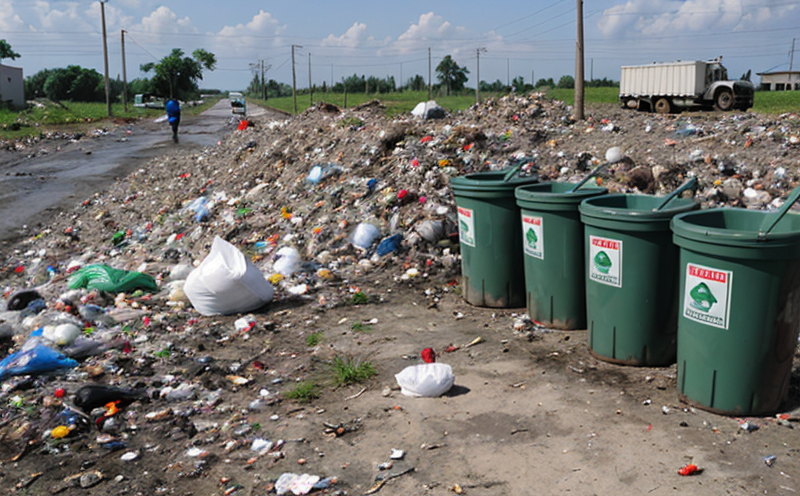ASTM D8333 Microplastics in Solid Waste Test
The ASTM D8333 standard testing method is pivotal for quantifying microplastics within solid waste samples. This methodology provides a robust framework for identifying and measuring microplastic particles, which are increasingly recognized as environmental pollutants. The test involves the extraction of microplastics from solid waste matrices using a combination of chemical solvents followed by filtration and visualization techniques.
The process begins with sampling solid waste materials, ensuring that representative samples are collected to reflect the composition accurately. Specimen preparation is critical; it includes sieving to ensure that only particles within the defined size range (typically between 10 microns and 5 mm) are analyzed. The sieved material undergoes dissolution in specific solvents designed to selectively extract microplastics without dissolving other organic or inorganic components.
The extracted solution is then filtered, with the retained particles subjected to visualization using advanced microscopy techniques such as scanning electron microscopy (SEM) and Fourier transform infrared spectroscopy (FTIR). These tools help confirm the presence of plastic materials by their unique spectral signatures. The test results provide a quantitative measure of microplastics present in solid waste, which is essential for understanding environmental impacts and informing regulatory compliance.
The ASTM D8333 method is particularly relevant in sectors dealing with hazardous waste management, recycling operations, and environmental impact assessments. Compliance officers and quality managers rely on this test to ensure that their processes are not contributing to the spread of microplastics into the environment. R&D engineers use these results to innovate sustainable practices and products.
The acceptance criteria for ASTM D8333 are stringent but necessary to ensure accuracy and reliability. Samples must be handled carefully to avoid contamination, and all steps in the extraction process must adhere strictly to the protocol. This ensures that the test yields consistent and reproducible results. Laboratories adhering to this standard are equipped with state-of-the-art instrumentation, including advanced microscopes capable of high-resolution imaging.
The ASTM D8333 method is widely recognized as a leading practice in the field, aligning with international standards such as ISO 15274-1 and EN 16360. This standardization ensures that results are comparable across different laboratories, which is crucial for regulatory compliance and scientific research.
Understanding the implications of microplastics on ecosystems and human health motivates continuous improvement in testing methods like ASTM D8333. By leveraging this method, stakeholders can make informed decisions to mitigate environmental risks effectively. The following table highlights some key industry applications:
| Industry Sector | Application of ASTM D8333 |
|---|---|
| Hazardous Waste Management | Detecting microplastics in hazardous waste streams to prevent environmental contamination. |
| Recycling Operations | Evaluating the purity of recycled materials, ensuring that microplastics do not compromise product quality or safety. |
| Environmental Impact Assessments | Assessing the impact of waste disposal on ecosystems and informing mitigation strategies. |
| Sustainable Product Development | Incorporating test results to design products that minimize microplastic shedding during use or recycling. |
| Regulatory Compliance | Ensuring compliance with increasingly stringent environmental regulations regarding microplastics in waste streams. |
In summary, ASTM D8333 is a crucial tool for solid waste testing, offering precise and reliable quantification of microplastics. Its role in various industries underscores its importance in addressing the growing concern over environmental pollution by microplastics.
Benefits
- Precise measurement of microplastic content within solid waste samples.
- Enhanced regulatory compliance through accurate quantification and reporting.
- Support for sustainable product development and recycling operations.
- Improved environmental impact assessments by identifying sources of pollution.
- Avoidance of potential legal issues arising from non-compliance with environmental regulations.
- Promotion of best practices in waste management, ensuring safer disposal methods.
- Enhanced understanding of the lifecycle and fate of microplastics within solid waste streams.
Industry Applications
The ASTM D8333 method finds extensive application across various industries, each leveraging its capabilities in unique ways. Here are some key industry sectors that benefit from this testing method:
| Industry Sector | Description of Application |
|---|---|
| Hazardous Waste Management | Detecting microplastics in hazardous waste streams to prevent environmental contamination. |
| Recycling Operations | Evaluating the purity of recycled materials, ensuring that microplastics do not compromise product quality or safety. |
| Environmental Impact Assessments | Assessing the impact of waste disposal on ecosystems and informing mitigation strategies. |
| Sustainable Product Development | Incorporating test results to design products that minimize microplastic shedding during use or recycling. |
| Regulatory Compliance | Ensuring compliance with increasingly stringent environmental regulations regarding microplastics in waste streams. |
| Construction and Demolition Waste Management | Evaluating the presence of microplastics in construction debris to inform recycling practices. |
| Plastic Manufacturing | Monitoring production processes for unintended microplastic generation or contamination. |
The versatility and precision of ASTM D8333 make it an indispensable tool across these industries, ensuring that stakeholders can take proactive steps to mitigate environmental impacts.





